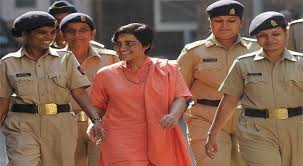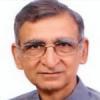Can there be two type of Justice delivery system in the same country? This question came to one’s mind with the U turn taken by NIA in the cases related to terror acts in which many Hindu names were involved. Now the NIA in a fresh charge sheet (May 13, 2016) has dropped the charges against Pragya Singh Thakur, has lightened the ones against Col Purohit and others. Along with this new line of NIA is that Hemant Karkare’s investigation in these cases was flawed and that it was ATS which had got the RDX planted in Purohit’s residence to implicate him in this case. The implication is that all this was being done at the behest of previous UPA Government.
 A brief recap is in order. Maharashtra in particular and many other places in the country were witness to acts of terror. The first major attention to this phenomenon took place when two Bajrang Dal activists were killed while making the bombs in the house of one RSS worker Rajkondawar (May 2006). There was a saffron flag flying atop the house and a board of Bajrang Dal was put up in front of the house. At the site of bomb explosion fake moustaches, beard and pajama-Kurta were also found. This was followed by many other blasts, Parbhani, Jalna, Thane, and Panvel etc. In most of these case police investigated on the lines in which generally Muslims were blamed for such acts. After every act of blast few Muslims young men were arrested who were later; after long grueling court cases; were released as no evidence was found against them.
A brief recap is in order. Maharashtra in particular and many other places in the country were witness to acts of terror. The first major attention to this phenomenon took place when two Bajrang Dal activists were killed while making the bombs in the house of one RSS worker Rajkondawar (May 2006). There was a saffron flag flying atop the house and a board of Bajrang Dal was put up in front of the house. At the site of bomb explosion fake moustaches, beard and pajama-Kurta were also found. This was followed by many other blasts, Parbhani, Jalna, Thane, and Panvel etc. In most of these case police investigated on the lines in which generally Muslims were blamed for such acts. After every act of blast few Muslims young men were arrested who were later; after long grueling court cases; were released as no evidence was found against them.
The Malegaon blast in which Sadhvi’s role came to surface; took place in 2008. In the blasts those returning from Namaj (prayers) were killed and many injured. Following this the usual suspects, Muslims, were arrested. Then while investigating the cases the Maharashtra ATS Chief Hemant Karkare found that the motorcycle used for the blast belonged to Sadhvi Pragya Singh Thakur, ex- ABVP worker. The trail of investigation led to Swami Dayanad Pande, Retd. Major Upadhyay, Ramji Klasnagra, Swami Aseemanand amongst others. They all belonged to the Hindu right wing politics. There was lots of evidence in the material recovered. One of the helpful evidence came in the form of the legally valid confession of Swami Aseemanand. This confession was made in judicial custody in presence of a Magistrate.
In the confession Swami spilled the beans and said that after the Sankat Mochan blast of 2002, they had decided that bomb will be replied by bomb. He was then looking after the VHP work in Dangs. He gave the detailed narrative of the whole process in which all the people were investigated and became part of the charge sheet of NIA.
When Karakare was investigating the case and many of Hindu names started coming under the shadow Bal Thackeray wrote in Saamna that ‘we spit on the face of Karakare’. Narendra Modi; then CM of Gujarat; called him Deshdrohi (Anti National). Advani also reprimanded Karkare. Feeling the heat of this pressure from Hindutva political outfits Karkare went to meet his professional peer Julio Rebeiro. Rebeiro. Rebeiro has a record of high level of professional integrity. Rebeiro appreciated his painstaking work. Karkare asked that what should be the stand of a person like him when facing such a heat from politicians. The senior officer told him to honestly do the work and ignore these insinuations.
Meanwhile the global terror phenomenon hit Mumbai. On 26/11 ten terrorists, armed to the teeth attacked Mumbai. On this occasion Karakre got killed. There is a strong controversy about this killing also. The then minority affairs Minister A. R. Antulay said that there is terrorism plus something else which is behind the killing of Karakare. Narendra Modi who had earlier called Karkare as Deshdrohi landed up in Mumbai and wanted to give a cheque of Rs. one Crore to widow of Karkare, she refused to accept the amount.
After Karkare’s death the investigations continued on the lines laid down by him. The charge sheet was ready and all the involved were to be tried for acts of terror. Meanwhile Government changed at the center and the NIA adopted the line which has led to the present situation where the efforts to release Sadhvi are marching with intimidating speed. The change in the line got reflected in the statement of Public Prosecutor, Rohini Salian. She stated that she was told to go soft on these cases. As she refused to toe this, she was sacked.
One recalls that in Mumbai 92-93 violence over one thousand people died. This carnage was followed by the bomb blasts in which over two hundred people died. As far as the communal carnage is concerned not many got severe punishments, no death penalty- no life imprisonment. In the cases of bomb blasts many have been given death penalty and many more life imprisonment. One of the people undergoing life imprisonment is Rubina Memon. Her crime, she owned the car which was used to ferry the explosives. She never drove the car with explosives.
Sadhvi owned the motor cycle used for Malegaon blasts; she will be out from the prison soon. Rubina owned the car; she will be in prison all her life. In Mumbai carnage so many died. No severe punishment to anybody. So many severe punishments in bomb blast case!
So where does our democracy stand at the end of all this? It seems two type of justice delivery systems are out there in the open. While shrill debates on TV will defend Sadhvi and blame Karkare for faulty investigation, the people in Malegaon are protesting furiously and planning to go to the court against the change in the stance of NIA. Two political parties seem to be preparing to save the honor of Karakare and press for sincere examination of the evidence collected by him.
One hopes the guilty will be punished and innocents will be protected. But this seems a bit too much to expect in current scenario!






Comments
Politicians made democracy biggest joke in india.... Now a days its a tool to manipulate Right to wrong and vice versa. May allah Curse these politicians.
Hindu terrorists are treated like VIP guests by the Indian govts and Indian police. After all they all are hindu. see their smiling faces. But sooner or later the God's justice will be delivered and on that day these hell dwellers will bleed and cry infinitely.
Karkare was killed because he was the honest officer.
Add new comment